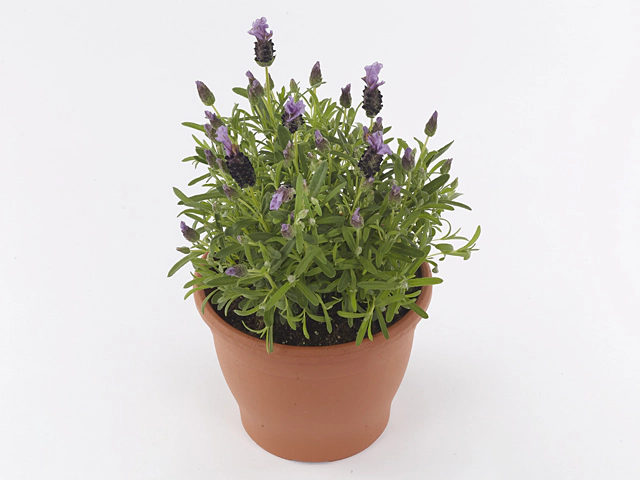Lavandula stoechas Lovendula Purple

| Flower scent | Sweet scented |
| Winter hardness | Reasonable (USDA-zone 7) |
| Flower color | Purple-medium blue violet-N082B |
| Leaf, general shape | Lanceolate |
| Leaf, scent | Pleasantly scented |
| Flower diameter | 1 - 10 mm |
| Plant height | 20 - 30 cm |
| Inflorescence | Spike |
| Flowering month(s) | March; April; May; June; July; August; September; October; February |
| Leaf size | 3 - 4 cm |
| soil pH requirement | Indifferent |
| Light conditions | Sunny |
| Inflorescence length | 5 - 10 cm |
| Inflorescence diameter | 1 - 2 cm |
| Leaf, main color | Grey green |
| Flower color distribution | Bicolored |
| Flower, secondary color(s) | Blue-dark blue-103A |
| Moisture requirements | Well-drained |
Lavender, scientifically known as Lavandula stoechas Lovendula Purple, is a stunning flowering plant that emanates a sweet scent. It is well-suited for regions with reasonable winter hardness, specifically USDA-zone 7. The captivating flower color of lavender ranges from a deep purple to a medium blue-violet shade, adding a touch of elegance to any garden.
The lanceolate-shaped leaves of lavender release a pleasantly scented fragrance, enhancing the overall sensory experience in its presence. The size of the flowers can vary from 1 to 10 mm in diameter, while the plant itself typically reaches a height of 20 to 30 cm.
Lavender blooms in abundance, with its inflorescence taking the form of a spike. Its flowering season extends from February to October, gracing the garden with its lovely presence throughout spring, summer, and early autumn. The leaves, measuring about 3 to 4 cm in size, exhibit a primary color of grey-green, adding a touch of subtlety to the plant's overall appearance.
Lavender prefers well-drained soil and can adapt to pH levels of varying degrees. It thrives best under sunny light conditions, making it an ideal plant for any garden or outdoor space that receives ample sunlight. The inflorescence of the lavender plant ranges from 5 to 10 cm in length and 1 to 2 cm in diameter, adding an eye-catching aspect to its overall aesthetic.
Not only does lavender possess beautiful blooms, but it also showcases an interesting bicolored flower color distribution. Additionally, the flowers exhibit secondary color variations of blue-dark blue, specifically classified as 103A.
Moisture-wise, lavender requires a well-drained environment, as excess water can hinder its growth and health. It is important to maintain an appropriate watering schedule, ensuring the soil doesn't become waterlogged.
In conclusion, Lavandula stoechas Lovendula Purple, commonly known as lavender, is a striking plant that adds beauty and fragrance to any garden. With its sweet-scented flowers, lanceolate-shaped leaves, and bicolored flower color distribution, lavender is truly captivating. It thrives best under sunny light conditions, in well-drained soil with an indifferent pH level. With proper care, this delightful plant can flourish and enhance the aesthetics of any outdoor space.
Market availability index by month:
| Jan. | Feb. | Mar. | Apr. | May | Jun. | Jul. | Aug. | Sep. | Oct. | Nov. | Dec. |
|---|---|---|---|---|---|---|---|---|---|---|---|
| 1 | 1 | 2 | 3 | 4 | 3 | 3 | 2 | 1 | 1 | 1 | 1 |